|
|
How Food Affects Your Blood Glucose
Whether you have type 1 or type 2 diabetes, what, when, and how much you eat all affect your blood glucose. Blood glucose is the main sugar found in the blood and the body's main source of energy.
If you have diabetes (or impaired glucose tolerance), your blood glucose can go too high if you eat too much. If your blood glucose goes too high, you can get sick.
Your blood glucose can also go too high or drop too low if you don't take the right amount of diabetes medicine.
If your blood glucose stays high too much of the time, you can get heart, eye, foot, kidney, and other problems. You can also have problems if your blood-glucose gets too low (hypoglycemia).
Keeping your blood-glucose at a healthy level will prevent or slow down diabetes problems. Ask your doctor or diabetes teacher what a healthy blood-glucose level is for you.
Blood-glucose Levels
What should my blood-glucose levels be?For most people, target blood-glucose levels are
|
Before meals 80 to 120 At bedtime 100 to 140 |
Talk with your health-care provider about your blood-glucose target levels. Print out this chart and write them in.
|
Before meals ______ to ______
At bedtime ______ to ______ |
Ask your doctor how often you should check your blood glucose. The results from your blood glucose checks will tell you if your diabetes care plan is working. Also ask your doctor for an A1C test at least twice a year. Your A1C number gives your average blood glucose for the past 3 months.
| Noninvasive
Blood Glucose Monitors
In March 2001, the U.S. Food and Drug Administration (FDA) approved a noninvasive blood glucose monitoring device for adults with diabetes. Noninvasive monitoring means checking blood-glucose levels without puncturing the skin for a blood sample. The GlucoWatch Biographer, manufactured by Cygnus Inc., was approved to detect glucose level trends and patterns in adults age 18 and older with diabetes. It must be used along with conventional blood glucose monitoring of blood samples. The device, which looks like a wristwatch, pulls body fluid from the skin using small electric currents. It checks blood-glucose levels every 20 minutes. Over the years, scientists have been trying to find noninvasive ways for people with diabetes to measure their blood glucose. Most methods of monitoring blood glucose require a blood sample, usually obtained by using an automatic lancing device on a finger. Some meters use a blood sample from a less sensitive area, such as the upper arm, forearm, or thigh. Some of the other noninvasive ways of being studied to measure glucose levels include:
|
How Can I Keep My Blood Glucose at a Healthy Level?
|
Eat about the same amount of food each day. | |
|
Eat your meals and snacks at about the same times each day. | |
|
Do not skip meals or snacks. | |
|
Take your medicines at the same times each day. | |
|
Exercise at about the same times each day. |
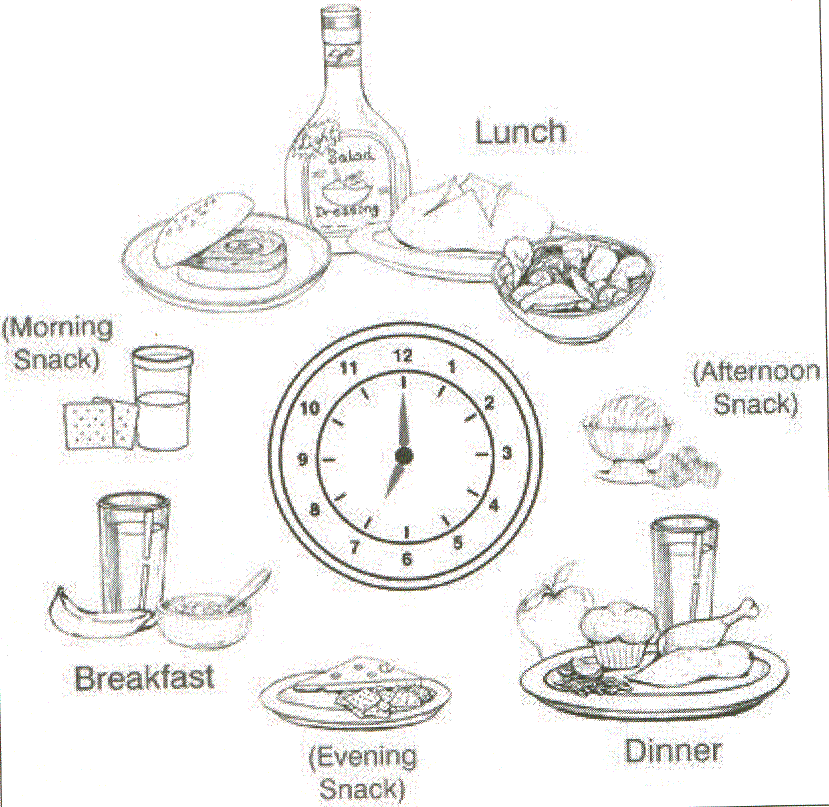 |
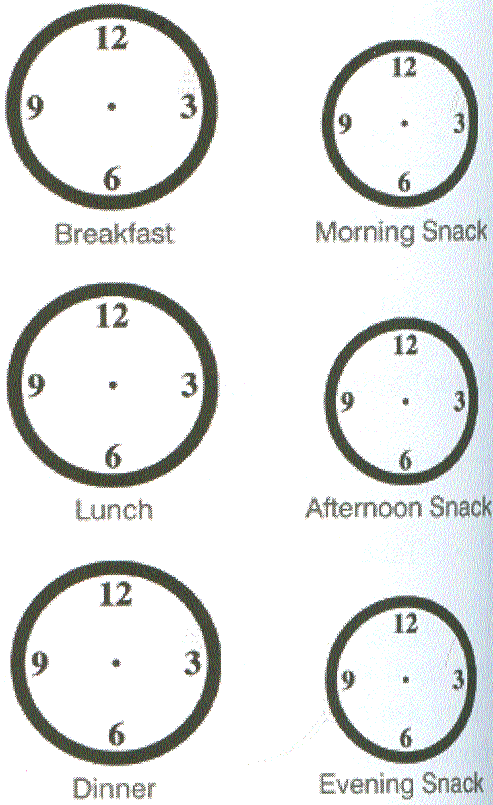 |
Why should I eat about the same amount at the same times each day?
Your blood glucose goes up after you eat. If you eat a big lunch one day and a small lunch the next day, your blood-glucose levels will change too much.
Keep your blood glucose at a healthy level by eating about the same amount of carbohydrate foods at about the same times each day. Carbohydrate foods, also called carbs, provide glucose for energy. Starches, fruits, milk, starchy vegetables such as corn, and sweets are all carbohydrate foods.
Talk with your doctor or diabetes teacher about how many meals and snacks to eat each day. Print out these clock faces and draw hands on the clocks to show when to have your meals and, if necessary, snacks.
Your Diabetes Medicines
What you eat and when affects how your diabetes medicines work. Talk with your doctor or diabetes teacher about the best times to take your diabetes medicines based on your meal plan.
Print out this chart. Fill in the names of your medicines, when to take them, and how much to take. If you take your medicine with a meal, write down the name of the meal. Draw hands on the clocks to show when to take your medicines.
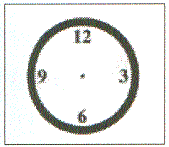 |
Name of medicine: __________________ Time: ________ Meal: _______________ How much: ________________________ |

|
Name of medicine: __________________ Time: ________ Meal: _______________ How much: ________________________ |

|
Name of medicine: __________________ Time: ________ Meal: _______________ How much: ________________________ |

|
Name of medicine: __________________ Time: ________ Meal: _______________ How much: ________________________ |
Your Exercise Plan
What you eat and when also depend on how much you exercise. Exercise is an important part of staying healthy and controlling your blood glucose. Physical activity should be safe and enjoyable, so talk with your doctor about what types of exercise are right for you. Whatever kind of exercise you do, here are some special things that people with diabetes need to remember:
|
Take care of your feet. Make sure your shoes fit properly and your socks stay clean and dry. Check your feet for redness or sores after exercising. Call your doctor if you have sores that do not heal. | |
|
Drink about 2 cups of water before you exercise, about every 20 minutes during exercise, and after you finish, even if you don't feel thirsty. | |
|
Warm up and cool down for 5 to 10 minutes before and after exercising. For example, walk slowly at first, then walk faster. Finish up by walking slowly again. | |
|
Test your blood glucose before and after exercising. Do not exercise if your fasting blood-glucose level is above 300. Eat a small snack if your blood glucose is below 100. | |
|
Know the signs of low blood-glucose (hypoglycemia) and how to treat it. |
Hypoglycemia
You should know the signs of hypoglycemia (low blood sugar) such as feeling weak or dizzy, sweating more, noticing sudden changes in your heartbeat, or feeling hungry. If you experience these symptoms, stop exercising and test your blood glucose. If it is 70 or less, eat one of the following right away:
|
2 or 3 glucose tablets | |
|
1/2 cup (4 oz.) of any fruit juice | |
|
1/3 cup of a regular (not diet) soft drink | |
|
3 average-sized pieces of hard candy |
After 15 minutes, test your blood-glucose again to find out whether it has returned to a healthier level. Once blood-glucose is stable, if it will be at least an hour before your next meal, itís a good idea to eat a snack.
To be safe when you exercise, carry something to treat hypoglycemia, such as glucose tablets or hard candy. Another good idea is to wear a medical identification bracelet or necklace (in case of emergency). Teach your exercise partners the signs of hypoglycemia and what to do about it.
The Food Pyramid
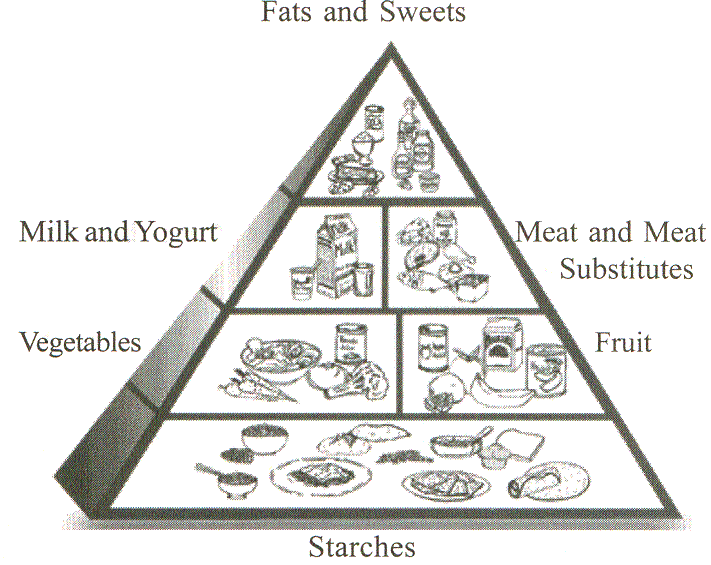 |
Eat a variety of food to get the vitamins and minerals you need. Eat more from the groups at the bottom of the pyramid, and less from the groups at the top.
How much should I eat each day?
Have about 1,200 to 1,600 calories a day if you are
|
a small woman who exercises | |
|
a small or medium woman who wants to lose weight | |
|
a medium woman who does not exercise much |
|
Talk with your diabetes teacher to make a meal plan that fits the way you usually eat, your daily routine, and your diabetes medicines. Then make your own plan.
Have about 1,600 to 2,000 calories a day if you are
|
a large woman who wants to lose weight | |
|
a small man at a healthy weight | |
|
a medium man who does not exercise much | |
|
a medium to large man who wants to lose weight |
|
Choose these many servings from these food groups to have 1,600 to 2,000 calories a day: 8 starches 2 milk and yogurt 4 vegetables 2 meat or meat substitute 3 fruit up to 4 fats |
Talk with your diabetes teacher to make a meal plan that fits the way you usually eat, your daily routine, and your diabetes medicines. Then make your own plan
Have about 2,000 to 2,400 calories a day if you are
|
a medium to large man who does a lot of exercise or has a physically active job | |
|
a large man at a healthy weight | |
|
a large woman who exercises a lot or has a physically active job |
|
Choose these many servings from these food groups to have 2,000 to 2,400 calories a day: 11 starches 2 milk and yogurt 4 vegetables 2 meat or meat substitute 3 fruit up to 5 fats |
Talk with your diabetes teacher to make a meal plan that fits the way you usually eat, your daily routine, and your diabetes medicines. Then make your own plan.
|
Make your food pyramid Print out this pyramid and fill in the numbers of servings next to the name of each food group. Each day, I need |
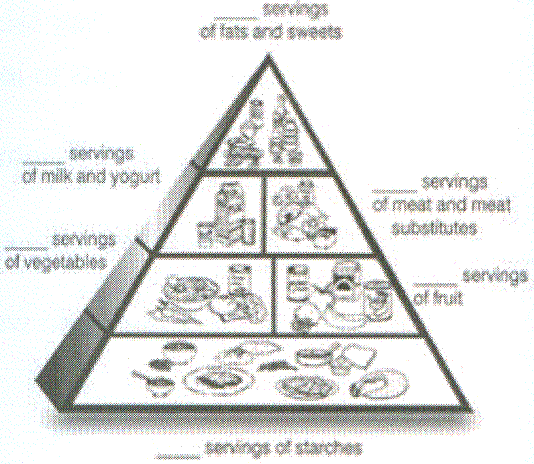 |
Starches
| Starches are bread, grains,
cereal, pasta, or starchy vegetables like corn and potatoes. They give
your body energy, vitamins, minerals, and fiber. Whole grain starches
are healthier because they have more vitamins, minerals, and fiber.
Eat some starches at each meal. People might tell you not to eat starches, but that is not correct. Eating starches is healthy for everyone, including people with diabetes. |
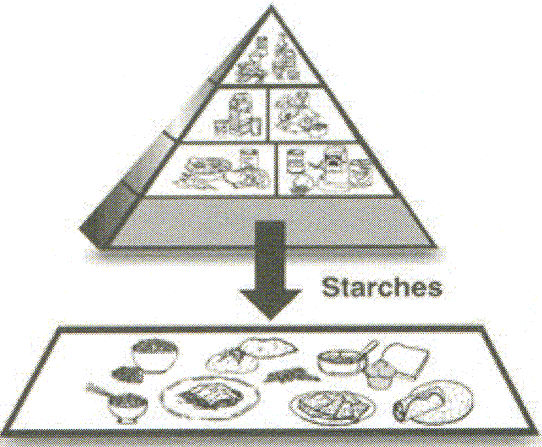 |
Examples of starches include
∑ bread ∑ potatoes ∑ tortillas
∑ pasta ∑ rice ∑ beans
∑ corn ∑ crackers ∑ yams
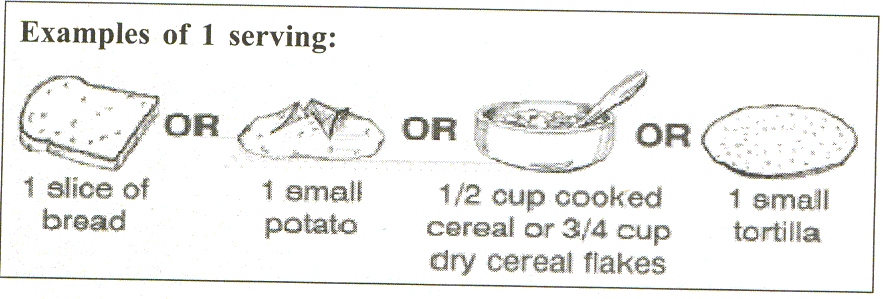 |
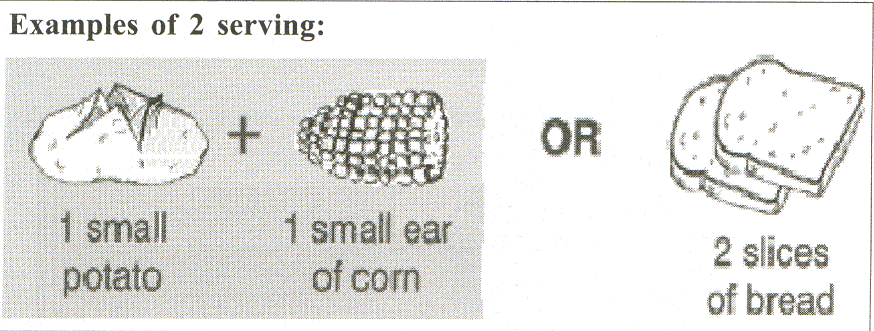 |
How much is a serving of starch?
If you have more than one serving at a meal, you can choose several different starches or have two or three servings of one starch.
Print out this chart. Then fill in the blanks with how many servings of starch to have at meals and snacks.
|
1. How many servings of grains, cereals, pasta, and starchy vegetables (starches) do you now eat each day? I eat _____ starch servings each day. 2. Check how many servings of starches to have each day in the section on How much should I eat each day. I will eat _____ starch servings each day. To control your blood glucose, spread the servings you eat throughout the day. 3. I will eat these many servings of starches at Breakfast _________ Snack _________ Lunch ___________ Snack _________ Dinner ___________ Snack _________ A diabetes teacher can help you with your meal plan. |
What are healthy ways to eat starch?
|
Buy whole grain breads and cereals. | |
|
Eat fewer fried and high-fat starches such as regular tortilla chips and potato chips, french fries, pastries, or biscuits. Try pretzels, fat-free popcorn, baked tortilla or potato chips, baked potatoes, or low-fat muffins. | |
|
Use low-fat or fat-free yogurt or fat-free sour cream instead of regular sour cream on a baked potato. | |
|
Use mustard instead of mayonnaise on a sandwich. | |
|
Use the low-fat or fat-free substitutes such as low-fat mayonnaise or light margarine on bread, rolls, or toast. | |
|
Eat cereal with fat-free (skim) or low-fat (1%) milk. |
Vegetables
| Vegetables give you vitamins,
minerals, and fiber, with very few calories.
Examples of vegetables include ∑ lettuce ∑ peppers ∑ salsa ∑ broccoli ∑ carrots ∑ chilies ∑ vegetable juice ∑ green beans ∑ greens |
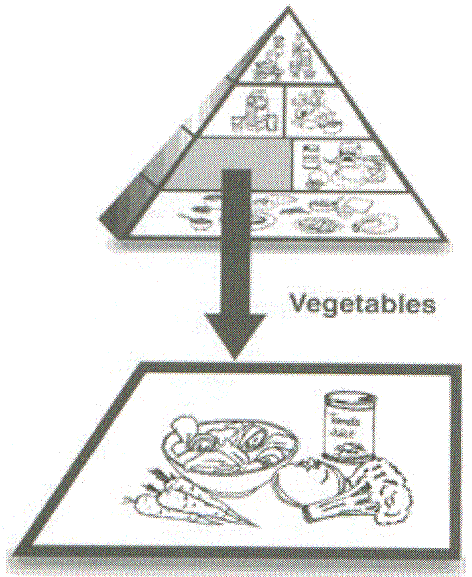 |
How much is a serving of vegetables?
 |
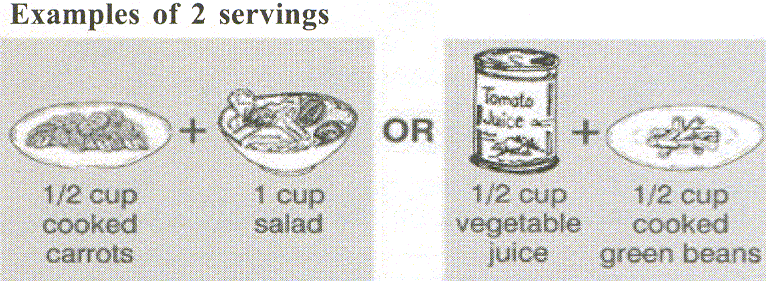 |
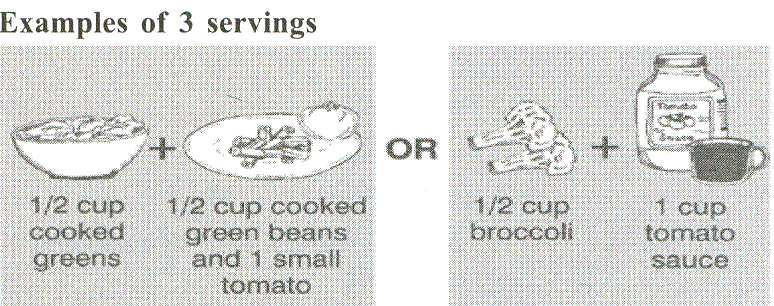 |
If you have more than one serving at a meal, you can choose a few different types of vegetables or have two or three servings of one vegetable.
Print out this chart. Then fill in the blanks with how many servings of vegetables to have at meals and snacks.
|
1. How many servings of vegetables do you now eat each day? I eat _____ vegetable servings each day. 2. Check how many servings of vegetables to have each day in the section on How much should I eat each day. I will eat___________vegetable servings each day. To control your blood glucose, spread the servings you eat throughout the day. 3. I will eat these many servings of vegetables at Breakfast_________ Snack _________ Lunch ___________ Snack _________ Dinner ___________ Snack _________ A diabetes teacher can help you with your meal plan. |
What are healthy ways to eat vegetables?
|
Eat raw and cooked vegetables with little or no fat, sauces, or dressings. | |
|
Try low-fat or fat-free salad dressing on raw vegetables or salads. | |
|
Steam vegetables using a small amount of water or low-fat broth. | |
|
Mix in some chopped onion or garlic. | |
|
Use a little vinegar or some lemon or lime juice. | |
|
Add a small piece of lean ham or smoked turkey instead of fat to vegetables when cooking. | |
|
Sprinkle with herbs and spices. These flavorings add almost no fat or calories. | |
|
If you do use a small amount of fat, use canola oil, olive oil, or soft margarines (liquid or tub types) instead of fat from meat, butter, or shortening. |
Fruit
| Fruit gives you energy,
vitamins, minerals, and fiber.
Examples of fruit include ∑ apples ∑ bananas ∑ mango ∑ fruit juice ∑ raisins ∑ guava ∑ strawberries ∑ oranges ∑ papaya How much a serving of fruit? If you have more than one serving at a meal, you can choose different types of fruit or have two servings of one fruit. |
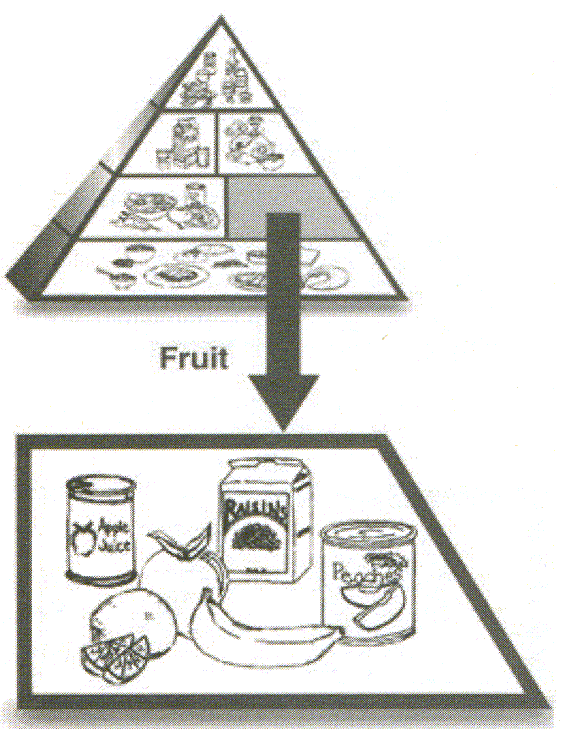 |
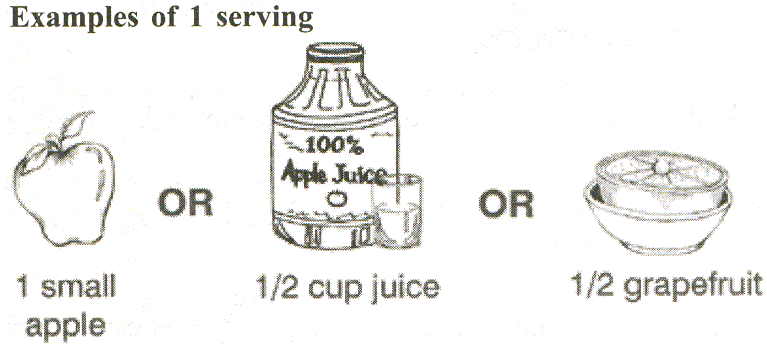 |
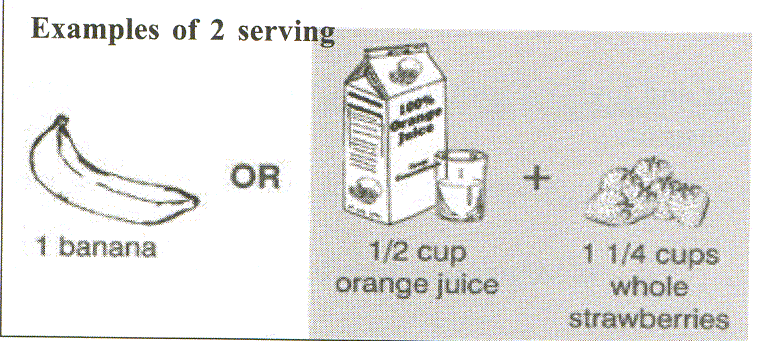 |
Print out this chart. Then fill in the blanks with how many servings of fruit to have at meals and snacks.
|
1. How many servings of fruit do you now eat each day? I eat _____ fruit servings each day. 2. Check how many servings of fruit to have each day in the section on How much should I eat each day. I will eat _____ fruit servings each day. To control your blood glucose, spread the servings you eat throughout the day. 3. I will eat these many servings of fruit at Breakfast _______ Snack ______ Lunch _________ Snack ______ Dinner _________ Snack ______ A diabetes teacher can help you with your meal plan. |
What are healthy ways to eat fruit?
Eat fruits raw or cooked, as juice with no sugar added, canned in their own juice, or dried.
|
Buy smaller pieces of fruit. | |
|
Eat pieces of fruit rather than drinking fruit juice. Pieces of fruit are more filling. | |
|
Drink fruit juice in small amounts. | |
|
Save high-sugar and high-fat fruit desserts such as peach cobbler or cherry pie for special occasions. |
Milk and Yogurt
|
Milk and yogurt give you energy, protein, fat, calcium, vitamin A, and other vitamins and minerals. How much is a serving of milk and yogurt? |
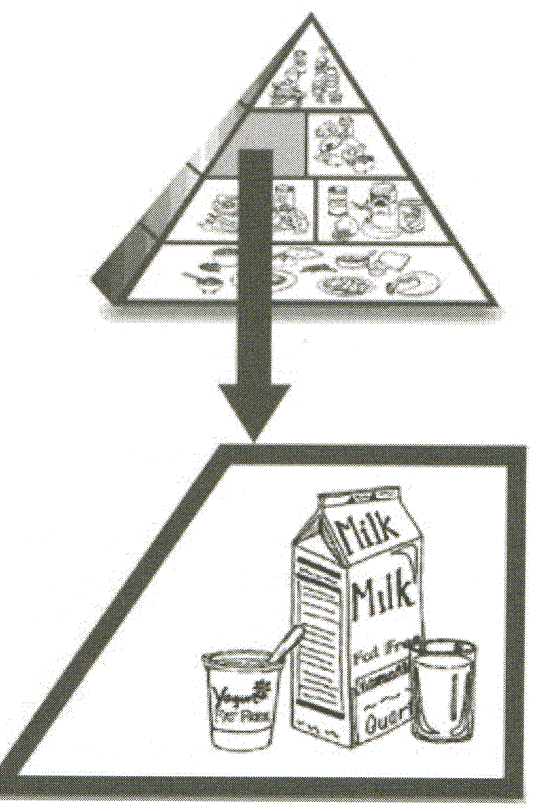 |
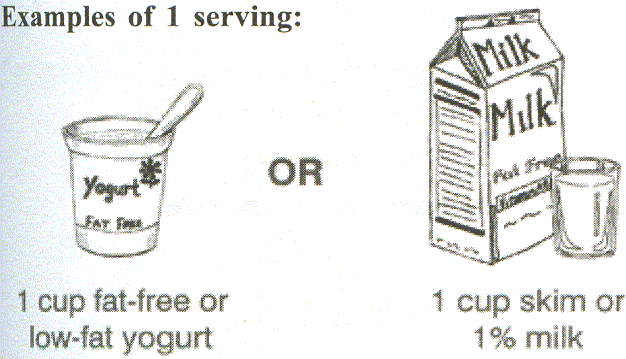 |
|
| Note: If you are pregnant or breast-feeding, have four to five servings of milk and yogurt each day. |
Print out this chart. Then fill in the blanks with how many servings of milk and yogurt to have at meals and snacks.
|
1. How many servings of milk and yogurt do you now have each day? I have _____ milk and yogurt servings each day. 2. Check how many servings of milk and yogurt to have each day in the section on How much should I eat each day. I will have ___________ milk and yogurt servings each day. To control your blood glucose, spread the servings you have throughout the day. 3. I will have this many servings of milk and yogurt at Breakfast ________ Snack ______ Lunch _________ Snack ______ Dinner _________ Snack ______ A diabetes teacher can help you with your meal plan. |
|
What are healthy ways to have milk and yoghurt?
Meat and Meat Substitutes The meat and meat substitutes group includes meat, poultry, eggs, cheese, fish, and tofu. Eat small amounts of some of these foods each day. Meat and meat substitutes help your body build tissue and muscles. They also give your body energy and vitamins and minerals. Examples of meat and meat substitutes include: ∑ chicken ∑ eggs ∑ cheese ∑ fish ∑ peanut butter ∑ ham ∑ beef ∑ tofu ∑ pork How much is a serving of meat or meat substitute? Print out this chart. Then fill in the blanks with how many servings of meat and meat substitutes to have at meals and snacks. |
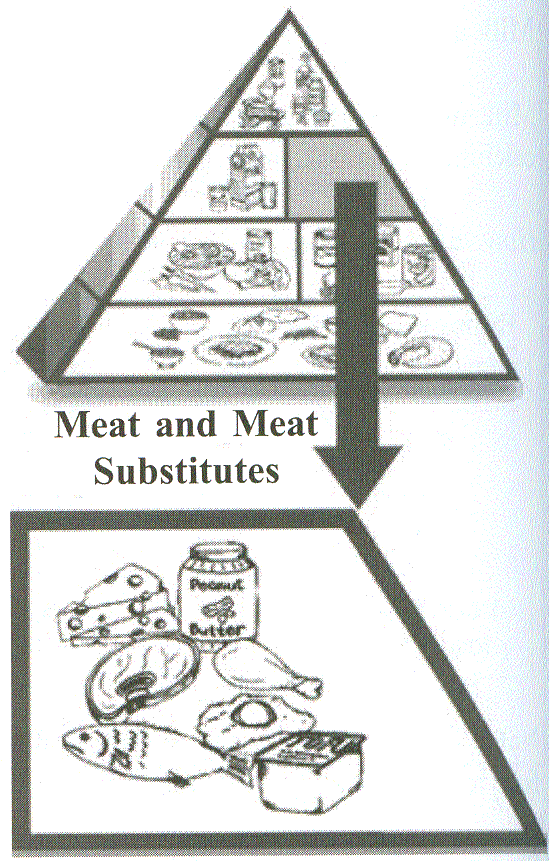 |
||||||
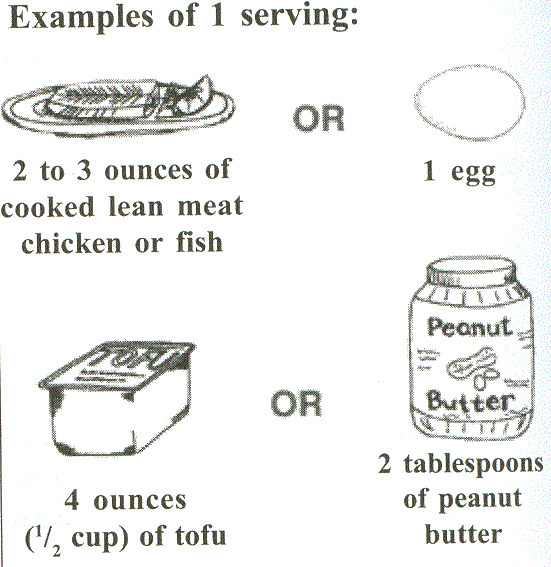 |
|
1. How many servings of meat or meat substitutes do you now eat each day? I eat _____ servings of meat or meat substitutes each day. 2. Check how many servings of meat or meat substitutes to have each day in the section on How much should I eat each day. I will eat _____ servings of meat or meat substitutes each day. To control your blood glucose, spread the servings you eat throughout the day. 3. I will eat these many servings of meat or meat substitutes at Breakfast _________ Snack ________ Lunch ___________ Snack ________ Dinner ___________ Snack ________ A diabetes teacher can help you with your meal plan. |
What are the healthy ways to eat meat or meat substitutes?
|
Buy cuts of beef, pork, ham, and lamb that have only a little fat on them. Trim off extra fat. | |
|
Eat chicken or turkey without the skin. | |
|
Cook meat or meat substitutes in low-fat ways: |
|
To add more flavor, use vinegars, lemon juice, soy or teriyaki sauce, salsa, ketchup, barbecue sauce, and herbs and spices. | |
|
Cook eggs with a small amount of fat or use cooking spray. | |
|
Limit the amounts of nuts, peanut butter, and fried chicken that you eat. They are high in fat. | |
|
Choose low-fat or fat-free cheese. |
Fats and Sweets
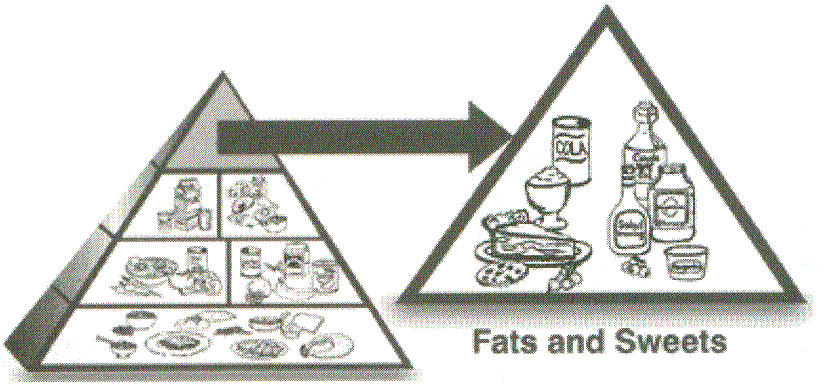 |
Limit the amounts of fats and sweets you eat. They have calories, but not much nutrition. Some contain saturated fats and cholesterol that increase your risk of heart disease. Limiting these foods will help you lose weight and keep your blood glucose and blood fats under control.
Examples of fats include
∑ salad dressing ∑ butter ∑ avocado
∑ oil ∑ margarine ∑ olives
Examples of sweets include
∑ regular soda ∑ cake ∑ pie
∑ ice cream ∑ cookies ∑ candy
How much is a serving of sweet?
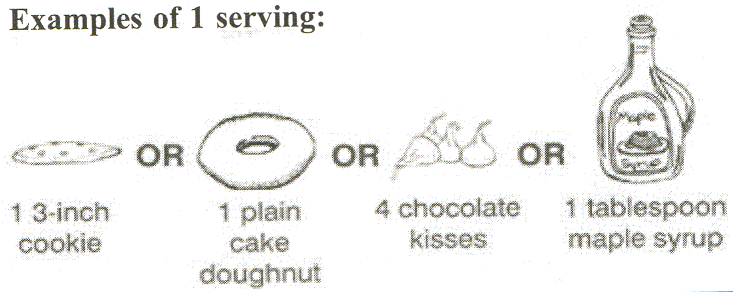 |
How much is a serving of fat?
 |
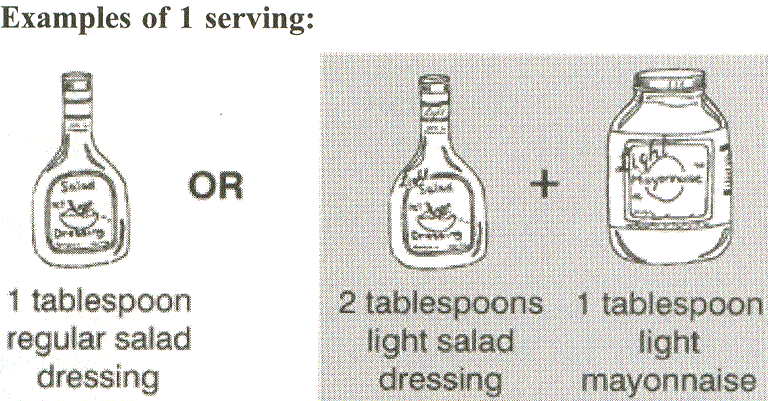 |
How can I satisfy my sweet tooth?
Itís okay to have sweets once in a while. Try having sugar-free popsicles, diet soda, fat-free ice cream or frozen yogurt, or sugar-free hot cocoa mix.
Other tips:
|
Share desserts in restaurants. | |
|
Order small or child-size servings of ice cream or frozen yogurt. | |
|
Divide homemade desserts into small servings and wrap each individually. Freeze extra servings. | |
|
Don't keep dishes of candy in the house or at work. |
Remember, fat-free and low-sugar foods still have calories. Talk with your diabetes teacher about how to fit sweets into your meal plan.
Alcohol
Alcohol has calories but no nutrients. If you drink alcohol on an empty stomach, it can make your blood-glucose level too low. Alcohol also can raise your blood fats. If you want to drink alcohol, talk with your doctor or diabetes teacher about how it fits into your meal plan.
Your Meal Plan
Print out this chart to plan your meals and snacks for one day. (Work with your diabetes teacher if you need help.)
|
Breakfast |
||
| Food Group | Food | How Much |
|
Snacks |
||
| Food Group | Food | How Much |
|
Lunch |
||
| Food Group | Food | How Much |
|
Snacks |
||
| Food Group | Food | How Much |
|
Dinner |
||
| Food Group | Food | How Much |
|
Snacks |
||
| Food Group | Food | How Much |
Measuring Your Food
To make sure your food servings are the right size, use:
|
measuring cups | |
|
measuring spoons | |
|
a food scale |
Also, the Nutrition Facts label on food packages tells you how much of that food is in one serving.
Weigh or measure foods to make sure you eat the right amounts.
These tips will help you choose the right serving sizes.
|
Measure a serving size of dry cereal or hot cereal, pasta, or rice and pour it into a bowl or plate. The next time you eat that food, use the same bowl or plate and fill it to the same level. | |
|
For one serving of milk, measure 1 cup and pour it into a glass. See how high it fills the glass. Always drink milk out of that size glass. | |
|
Meat weighs more before it's cooked. For example, 4 ounces of raw meat will weigh about 3 ounces after cooking. For meat with a bone, like a pork chop or chicken leg, cook 5 ounces raw to get 3 ounces cooked. | |
|
One serving of meat or meat substitute is about the size and thickness of the palm of your hand or a deck of cards. | |
|
A small fist is equal to about 1/2 cup of fruit, vegetables, or starches like rice. | |
|
A small fist is equal to 1 small piece of fresh fruit. | |
|
A thumb is equal to about 1 ounce of meat or cheese. | |
|
The tip of a thumb is equal to about 1 teaspoon. |
When You Are Sick
Itís important to take care of your diabetes even when you're ill. Here are some tips on what to do:
|
Even if you canít keep food down, keep taking your diabetes medicine. | |
|
Drink at least one cup (8 ounces) of water or other calorie-free, caffeine-free liquid every hour while you're awake. | |
|
If you canít eat your usual food, try drinking juice or eating crackers, popsicles, or soup. | |
|
If you canít eat at all, drink clear liquids such as ginger ale. Eat or drink something with sugar in it if you have trouble keeping food down, because you still need calories. If you don't have enough calories, you increase your risk of hypoglycemia (low blood sugar). | |
|
Make sure that you check your blood glucose. Your blood-glucose level may be high even if you're not eating. | |
|
Call your doctor right away if you throw up more than once or have diarrhea for more than 6 hours. |
Point to Remember
| What, when, and how much you eat all affect your blood-glucose level. | |
| You can keep your blood glucose at a healthy level if you |
|
Every day, choose foods from these food groups: starches, vegetables, fruit, meat and meat substitutes, and milk and yogurt. How much of each depends on how many calories you need a day. | |
|
Limit the amounts of fats and sweets you eat each day. |
How to Find More Help
Diabetes Teachers (nurses, dietitians, pharmacists, and other health professionals)To find a diabetes teacher near you, call the American Association of Diabetes Educators toll-free at 1-800-TEAMUP4 (1-800-832-6874) or see www.aadenet.org and click on "Find an Educator."
Recognized Diabetes Education Programs (teaching programs approved by the American Diabetes Association)
To find a program near you, call toll-free 1-800-DIABETES (1-800-342-2383) or see www.diabetes.org and click on "Diabetes Info."
Dietitians
To find a dietitian near you, call the American Dietetic Association's National Center for Nutrition and Dietetics toll-free at 1-800-366-1655 or see www.eatright.org and click on "Find a Dietitian."